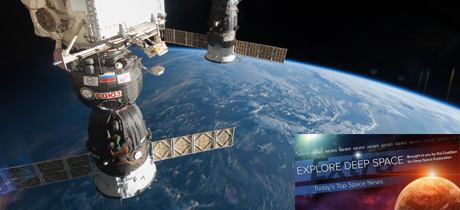In Today’s Deep Space Extra… A Soyuz capsule suffered a small leak leading to partial depressurization during the return to Earth of three ISS crew members in April. A call from Vice President Mike Pence, chair of the newly re-established National Space Council, to return U.S. astronauts to the moon earlier this month gains traction among companies interested in developing capabilities for use on or near the moon.
Human Space Exploration
Soyuz capsule suffered partial depressurization during April landing
Space News (10/17): Russia’s Soyuz MS-02 sustained a small pressure leak in April, when it descended to Earth with a NASA astronaut and two cosmonauts ending their tours of duty aboard the International Space Station, the chair of NASA’s International Space Station Safety Advisory Board reported during a Monday session. The leak was attributed to damage to a weld seal on the capsule from a parachute system component. All three men were wearing pressure suits at the time, when the capsule was about five miles in altitude.
Air and Space Magazine (10/17): The U.S. should aim for a human return to the moon to learn how to arrive, survive and thrive off the Earth, writes Paul Spudis, a planetary geologist and lunar expert, in response to the Vice President’s October 5 call for a new direction of the nation’s space program.
Companies seek roles in NASA’s return to the moon
Coalition Member in the News (Astrobiotic)
Space News (10/17): Blue Origin, Astrobotic, Masten Space Systems and Moon Express are among the enterprises lining up to support a White House National Space Council call to return to the moon. Each has a commercial strategy for reaching the lunar surface for its customers and outlined its capabilities at a meeting of the NASA Lunar Exploration Assessment Group last week. Vice President Mike Pence chaired the first session of the re-established National Space Council on October 5.
Bigelow Aerospace and ULA widen their sights to plan an outpost in lunar orbit
Coalition Member in the News (United Launch Alliance)
GeekWire.com (10/17): Under the agreement, multiple launches of ULA’s new Vulcan rocket would place a Bigelow Aerospace B330 Habitat in low Earth orbit, fuel it and then transition the expandable habitat to lunar orbit. The effort could get underway in 2022, according to the company.
Space Science
The world looks different after today’s big neutron star collision discovery
Mashable (10/17): Observations of a neutron star merger unveiled in prominent science journals this week and including the efforts of dozens of scientists from around the world include a footnote that may change how we look at jewelry. The mergers are also responsible for the production of valuable gold, platinum and uranium metals.
Gravitational waves show how fast the universe is expanding
Discovery magazine (10/16): Gravity wave observations from the recent merger of two neutron stars may lead to many other discoveries, including a more accurate measure of the rate at which the universe is expanding.
Mysterious particles spotted in Saturn’s atmosphere
Nature.com (10/18): During its September 15 plunging demise into Saturn’s atmosphere, NASA’s long running Cassini mission discovered small unexpected particles that originated in the large planet’s famous ring system. With its mission at an end, Cassini plunged to avoid allowing terrestrial contamination to reach the moons Enceladus and Titan, both of which may host habitable environments.
Other News
NASA to test fission reactor for space missions
Subscription required
Aviation Week (10/17): Testing of NASA’s Kilopower fission reactor as a potential future deep space power source is to get underway November 1 at the Nevada National Security Site.
Crash scene investigation: Resting place of ESA’s first lunar mission found
SpaceFlightInsider.com (10/17): NASA’s long running Lunar Reconnaissance Orbiter mission has identified the crash site for the European Space Agency’s Smart-1 mission, which among other objectives served as a test bed for solar electric propulsion and other deep space technology candidates. It impacted the lunar surface in 2006, three years after its launching.

